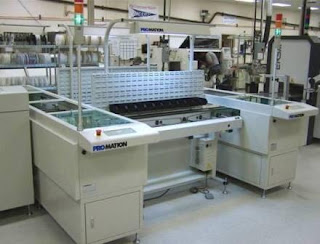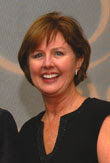 The most-uttered phrases at APEX this year including the expected “surface mount,” and “BGA,” and the like, but another vocabulary set is rapidly gaining traction with exhibitors and OEM/EMS attendees. “Solar cells” and “photovoltaics” were on many people’s minds, as the mature SMT industry reaches into the emerging markets available to exchange information and develop processes. Solder suppliers, printing companies, chemists, and oven manufacturers are a few of the companies promoting solar manufacturing technology for the electronics manufacturing crowd.
The most-uttered phrases at APEX this year including the expected “surface mount,” and “BGA,” and the like, but another vocabulary set is rapidly gaining traction with exhibitors and OEM/EMS attendees. “Solar cells” and “photovoltaics” were on many people’s minds, as the mature SMT industry reaches into the emerging markets available to exchange information and develop processes. Solder suppliers, printing companies, chemists, and oven manufacturers are a few of the companies promoting solar manufacturing technology for the electronics manufacturing crowd.Electronic Trend Publications (ETP) reports that capacity of photovoltaic modules (panels) sold in 2008 exceeded 4.9 gigawatts, a nearly 25% increase over 2007. The market is expected to grow to more than 15 gigawatts in 2013 and 44 gigawatts by 2023, and be a leading vertical market for product assembly for both OEMs and CMs, ETP notes.
The factory cost of producing photovoltaic modules was $9.8 billion in 2008 and will grow to $52 billion in 2023, a compound annual growth rate of 11.8%. Photovoltaic cell producers are looking to outsource module assembly to capable industry suppliers and EMS providers. Outsourcing will grow to 4% in 2013 and 25% in 2023, as OEMs seek a competitive cost advantage, ETP predicts.
Virtual Industries, which makes vacuum tweezers for handling components and wafers, offers custom applications for the solar market. Many customers will purchase vacuum handling tips to integrate into automated systems, making handling equipment an easy retrofit from electronics components to solar wafers. Retrofits are also an option for dispensing systems, and companies like Techcon Systems, a division of OK International, are expanding into the photovoltaics manufacturing sector. “We’ve had three successes for valves and pumps in the solar market in the past six months,” noted Bryan Gass, VP of the OEM division at Techcon.
In the field of metals and chemicals, distributors like K.R. Anderson Inc. see solar as a yet-untapped manufacturing market. It is the future of our industry, and yet a great deal of companies entering the photovoltaics manufacturing market don’t have a solid understanding of the materials involved, said Jeff Wagner, sales manager, K.R. Anderson. As a distributor with a narrow focus — carrying less than 10 core lines — the company feels it can partner with materials suppliers and new solar customers to understand and troubleshoot problems and develop easier to use, better performance products. This requires an investment in technical staff that is difficult for assemblers facing tight margins and reduced personnel resources, added Wagner. This “middle man” position of the distributor actually can benefit the electronics assembler, much like an outsourced R&D/failure analysis lab.
Major equipment manufacturers also are pointing electronics manufacturers' attentions to familiar equipment with applications beyond PCBs and ICs.
Assembléon, a capital equipment supplier, is immersing itself in the green energy concept, from its own machines to the products its customers manufacture. Among the promising innovations is the YGP screen printer, which uses a servo-controlled single-sided squeegee blade. This design keeps solder paste in front of the stencil at roll-in, which reduces sheer and maintains solder paste composition. This technology will prove beneficial for solar cell manufacturers trying to achieve taller, narrower metallization fingers on solar cell surfaces. By preserving the integrity of the metal materials, the stencil enables users to implement smaller apertures and thicker stencils.
Reflow oven supplier BTU International has increasingly developed products for the solar manufacturing market in recent years, both silicon and thin film. The company is also rolling out new products for the traditional electronics market. Paul Van Der Wansem, chairman, president, and CEO, BTU, explained that solar makes the electronics sector stronger, both with R&D sharing to enhance products in both markets and with global infrastructure improvements to the electronics supply chain. Aspects like better temperature control and oven power can benefit electronics manufacturers and photovoltaics producers, perhaps in the same EMS or OEM factory.
Look for DEK’s cover story in the upcoming May/June issue of SMT for more on the convergence and collaboration between electronics and solar manufacturers, including how solder print technology can be adapted to improve metallization on the surface of photovoltaics, improving current-carrying capacity and minimizing the shading effect on cell efficiency.
Meredith Courtemanche, managing editor






